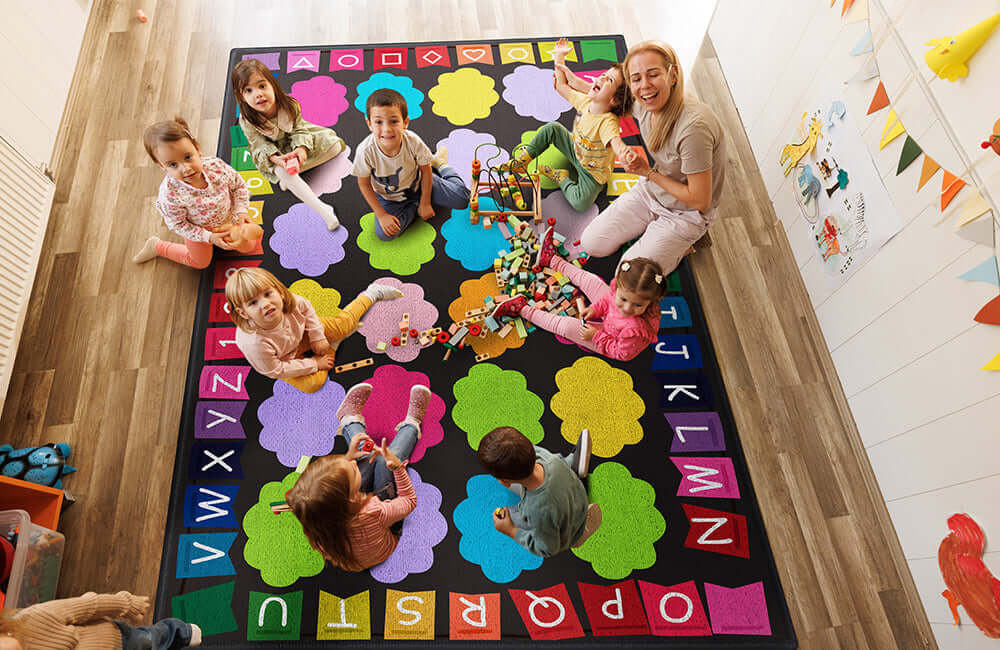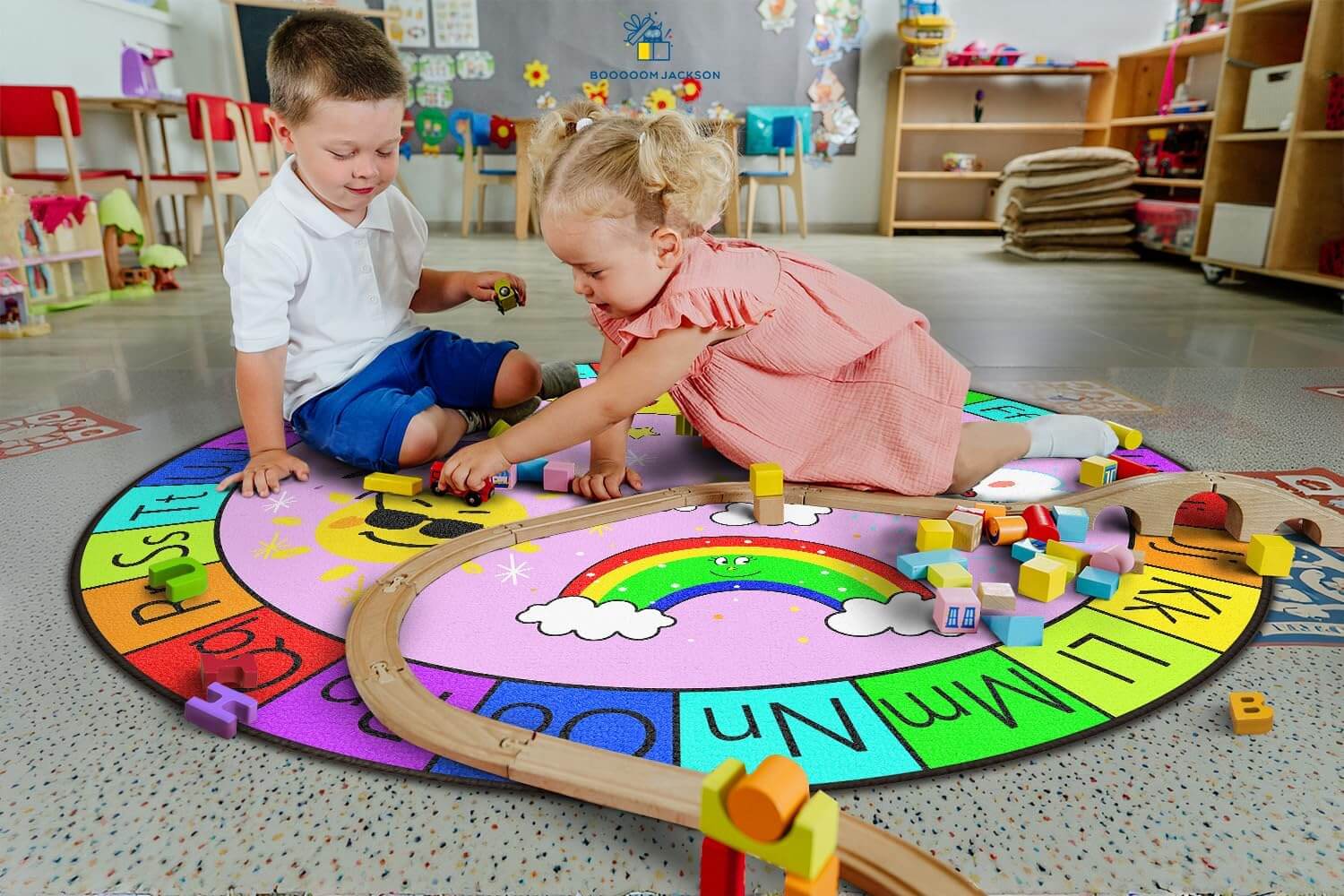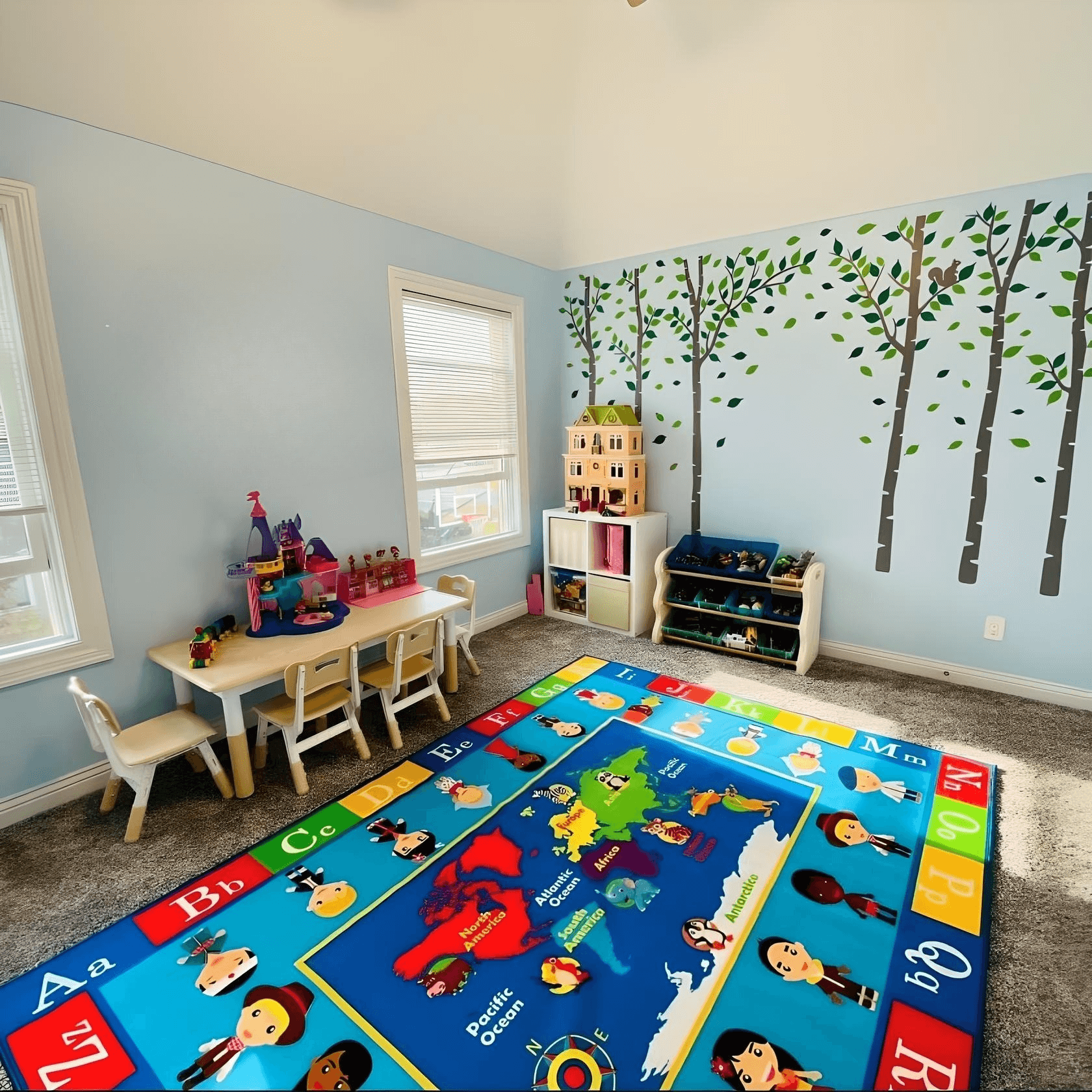Infant Stage (0-12 months): Foundation for Exploration {#infant-stage}
The first year of life is characterized by rapid sensory development and the progression from immobile newborn to active crawler or early walker. Carpet choices during this critical period require special consideration.
Sensory Development Needs
Infants explore their world primarily through their senses. According to child development researchers, the right sensory inputs during this period literally shape brain architecture. Ideal carpets for this stage include:
- High-contrast patterns that stimulate visual tracking and focus
- Varied textures that provide tactile stimulation during tummy time
- Soft surfaces that cushion falls and support early mobility
- Defined visual zones that help babies differentiate spaces
Our Sensory Start Collection specifically addresses these developmental needs through thoughtfully designed patterns and textures.
Safety Considerations
Safety is paramount during the infant stage when everything eventually makes its way to the mouth:
- Hypoallergenic materials reduce potential allergen exposure
- Non-toxic dyes and treatments ensure safe oral exploration
- Zero VOC (volatile organic compounds) options prevent harmful off-gassing
- Antibacterial treatments provide protection without harsh chemicals
As noted by pediatric environmental health specialists, these safety features are particularly important during the first year when infants spend significant time in direct floor contact.
Practical Features
The infant stage brings unique practical challenges:
- Stain-resistant fibers withstand frequent spit-up incidents
- Moisture-resistant backing protects against diaper leaks
- Easy-clean surfaces allow for quick sanitizing
- Optimal pile height (not too short, not too long) facilitates early crawling
Our Easy Care Collection offers solutions specifically designed for the practical challenges of the infant stage.
Toddler Years (1-3 years): Supporting Independence {#toddler-years}
Toddlerhood brings explosive physical development and the first real assertions of independence. Floor coverings need to keep pace with newfound mobility and increasingly complex play.
Motor Skill Development
Toddlers are physical development powerhouses, requiring carpets that:
- Provide secure footing for new walkers while still offering appropriate resistance
- Include pathways and roadways to practice walking, running, and navigating space
- Feature activity zones for climbing, jumping, and active play
- Incorporate varied textures to challenge developing balance and coordination
According to early childhood movement specialists, these physical challenges are essential for developing bodily control and spatial awareness.
Cognitive Engagement Features
Toddlers are also cognitive sponges, benefiting from carpet features that:
- Incorporate basic shapes for early recognition and naming
- Include primary colors for identification and vocabulary building
- Feature simple counting elements like dots, animals, or objects
- Provide recognizable images like animals, vehicles, or familiar objects
Our Toddler Discovery Collection integrates these elements while maintaining the durability needed for this high-energy stage.
Practical Requirements
The toddler years bring legendary messiness, necessitating practical features:
- Maximum stain resistance to withstand food spills and art mishaps
- Quick-dry technology for inevitable liquid accidents
- Low maintenance fibers that retain appearance despite heavy use
- Sectional options that allow for replacing only damaged portions
As parenting experts acknowledge, finding this balance between practicality and developmental support is crucial during the wonderfully chaotic toddler years.
Preschool Period (3-5 years): Learning Through Play {#preschool-period}
The preschool years see dramatic cognitive development alongside increasingly sophisticated physical abilities and social skills. Carpets now serve as learning tools as well as play surfaces.
Educational Features
Preschoolers are eager learners who benefit from carpets incorporating:
- Alphabet elements to support early literacy
- Number grids and counting features for mathematical foundations
- Calendar concepts like days, months, and seasons
- Simple map features for geographic awareness
Our Preschool Prep Collection is specifically designed to support kindergarten readiness through playful interaction with these concepts.
Imaginative Play Support
Imagination blossoms during the preschool years, with carpet needs including:
- Thematic designs like fairy tales, space exploration, or underwater worlds
- Open-ended play elements that can be interpreted in multiple ways
- Clear but flexible boundaries for different types of play
- Strategic blank spaces that children can mentally transform
As child psychology researchers note, these imaginative play opportunities are critical for developing creativity and problem-solving skills.
Social Development Considerations
Preschoolers become increasingly social, benefiting from carpets that:
- Designate sharing spaces for collaborative play
- Include game elements like hopscotch or simple board games
- Create natural gathering spots for group activities
- Define personal spaces while encouraging interaction
Our Social Skills Collection addresses these emerging social needs through thoughtful design elements.
Early Elementary (6-8 years): Growing Interests {#early-elementary}
The early elementary years bring more structured learning alongside developing hobbies and interests. Carpet needs diversify to support increasingly specialized activities.
Academic Support Features
School-aged children benefit from carpet elements that:
- Reinforce classroom learning through subtle educational elements
- Include more complex patterns for mathematical thinking
- Incorporate word games or language elements to support literacy
- Feature scientific concepts like the solar system or plant life cycles
Our Elementary Enrichment Collection complements school curriculum while maintaining appealing designs that don't feel overly educational.
Interest and Hobby Zones
As children develop distinct interests, carpet needs include:
- Designated activity areas for collections, crafts, or hobbies
- Theme-specific designs matching interests like sports, nature, or arts
- Durable surfaces for LEGO building, crafting, or game playing
- Easy-clean options for art areas and experiment zones
According to educational psychologists, supporting these emerging interests helps build concentration and perseverance.
Practical Evolutions
The school years bring new practical considerations:
- Homework-friendly surfaces that reduce eye strain during floor study
- Stain treatments specifically designed for art supplies and school projects
- More sophisticated color schemes that complement evolving room décor
- Greater durability for increased foot traffic from friends
Our School Years Collection balances these practical needs with age-appropriate design elements.
Middle Childhood (9-12 years): Social Development {#middle-childhood}
The tween years bring increasing social awareness, the beginning of abstract thinking, and growing independence, all reflected in changing carpet preferences.
Social Space Requirements
Tweens' social lives become increasingly important, necessitating carpets that:
- Create inviting gathering areas for friends
- Include subtle game elements for social interaction
- Provide conversation-friendly arrangements without appearing childish
- Offer comfortable surfaces for lounging during social time
Our Tween Social Collection creates these versatile social spaces while respecting tweens' increasing design opinions.
Learning Space Evolution
Academic demands increase during these years, requiring:
- Defined study zones with appropriate lighting and comfort
- Less distracting patterns in areas designated for concentration
- Surfaces compatible with technology use for research and projects
- Acoustic properties that support focus and reduce distractions
As noted by educational environment researchers, these thoughtful design elements can significantly impact academic success.
Style Awareness
Tweens develop stronger aesthetic preferences:
- More sophisticated color palettes that feel less "childish"
- Abstract or geometric patterns rather than cartoon characters
- Trendy elements that reflect current interests
- Style flexibility that accommodates rapidly changing tastes
Our Style Transition Collection specifically addresses this challenging in-between stage with designs that grow alongside evolving tastes.
Teenage Years (13+ years): Identity and Independence {#teenage-years}
Teenagers require spaces that respect their emerging adult identities while still providing appropriate support for this critical developmental stage.
Identity Expression
Teens use their environments to express their identities:
- Bold or unique designs that stand out from childhood styles
- Customizable elements that can be personalized
- On-trend colors and patterns that feel current and relevant
- Higher-end materials that signal maturation
Our Teen Expression Collection offers sophisticated options that respect teens' design sensibilities while maintaining durability for active use.
Functionality for Teen Life
Teenage activities require specific carpet features:
- Durable surfaces for increasingly adult-sized bodies and activities
- Tech-friendly elements like built-in cable management or static reduction
- Sound-dampening properties for music, gaming, and social gatherings
- Stain-resistance that handles increasingly complex spills (energy drinks, makeup)
According to adolescent development specialists, creating appropriate teen spaces supports healthy development and independence.
Multi-Purpose Flexibility
Teen rooms often serve multiple functions:
- Zone-creating designs that separate sleep, study, and social areas
- Modular options that can be reconfigured as needs change
- Sophisticated yet practical surfaces for varied activities
- Easy-maintain features that accommodate busy teen schedules
Our Teen Living Collection provides these versatile solutions that respect both teen style preferences and practical needs.
Practical Considerations Across Ages {#practical-considerations}
While specific needs evolve, some practical carpet considerations span all childhood stages.
Health and Safety Features
At every age, carpet choices should prioritize:
- Non-toxic materials appropriate for the child's interaction level
- Allergen management capabilities to reduce environmental triggers
- Appropriate pile height for the child's mobility level and activities
- Slip-resistant backing to prevent accidents
As noted by environmental health researchers, these considerations remain important throughout childhood, though specific requirements may change.
Durability and Longevity
Investment in quality pays dividends:
- Fiber selection appropriate for the intensity of use at each stage
- Stain-resistance technology matched to age-appropriate messes
- Construction quality that withstands common activities
- Warranty coverage that recognizes real-world family use
Our Lifetime Value Collection offers exceptional durability across all childhood stages.
Cleaning and Maintenance
Practical care considerations include:
- Age-appropriate cleaning requirements (more frequent for younger children)
- Compatible with common household cleaning methods
- Resistant to cleaning chemicals necessary for sanitization
- Quick-drying properties to reduce downtime after cleaning
Visit our Care Guide for stage-specific cleaning recommendations.
Making Transitions: When to Update Your Child's Carpet {#making-transitions}
Knowing when to transition between carpet styles is as important as the initial selection.
Developmental Milestones
Consider carpet updates around key transitions:
- From infant to mobile toddler (crawling to walking stage)
- Starting formal education (preschool or kindergarten)
- Middle school transition (around age 11-12)
- Teen room redesign (typically around 13-14)
According to childhood transition specialists, these natural breakpoints often align with children's changing needs and preferences.
Physical Indicators
Practical signs it's time for an update include:
- Visible wear patterns in high-traffic areas
- Stains that no longer respond to cleaning
- Flattened pile that doesn't recover with cleaning
- Backing deterioration or edge fraying
Our Carpet Assessment Guide helps determine when replacement makes more sense than continued maintenance.
Emotional Readiness
Children often signal readiness for change:
- Expressing dissatisfaction with current carpet design
- Showing interest in more "grown-up" options
- Requesting changes to match new interests or activities
- Demonstrating care for their physical environment
As child psychology experts note, respecting these preferences supports healthy autonomy development.
Conclusion {#conclusion}
The journey from baby's first play mat to teenager's statement carpet reflects the remarkable developmental journey of childhood itself. At each stage, thoughtfully selected floor coverings do more than just protect floors—they actively support physical, cognitive, social, and emotional development while meeting the practical needs of busy family life.
At Booom Jackson, we're committed to creating carpets that grow alongside children, offering age-appropriate solutions for every stage from tummy time to teen study sessions. By understanding the unique needs of each developmental period, parents can make informed choices that enhance their children's environments while managing practical concerns like durability, maintenance, and value.
Explore our age-specific collections to find the perfect carpet for your child's current developmental stage, or contact our design consultants for personalized recommendations based on your child's unique needs and interests.
Remember that the perfect carpet does more than cover your floor—it creates the foundation for the countless moments of growth, learning, and joy that make up the extraordinary journey of childhood.




Leave a comment
This site is protected by hCaptcha and the hCaptcha Privacy Policy and Terms of Service apply.